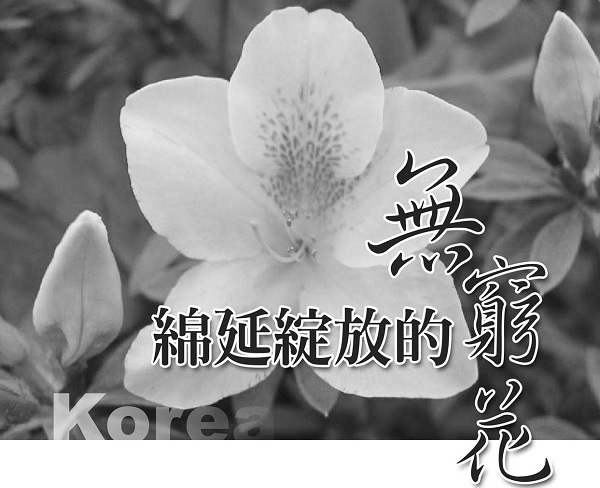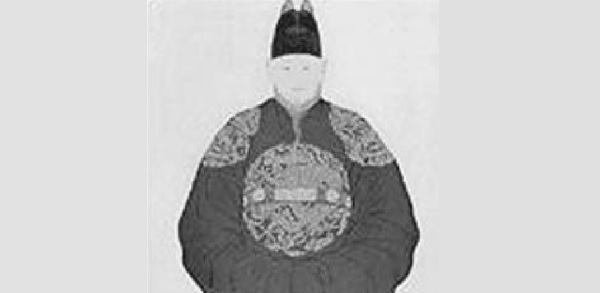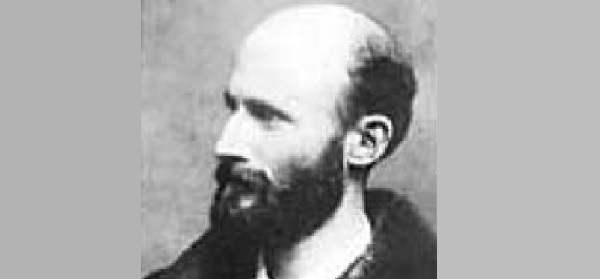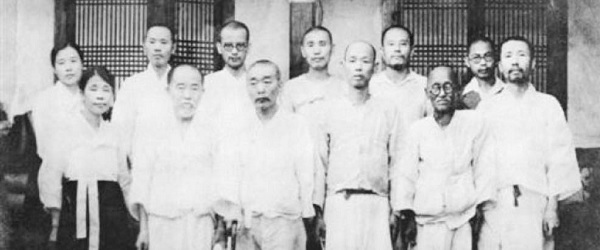Continuously blooming infinite flowers: Characteristics of the historical development of the Korean Church

The Korean Peninsula, located in the northeast corner of the Asian continent, extends into the Sea of Japan and the Yellow Sea, which are rich in seafood. It is adjacent to China through the natural barriers of Changbai Mountain and the Yalu River; it faces Japan across the Tsushima Strait. In this land that still seems to be attached to the mainland but is isolated by mountains and rivers, a nation with bright temperament and pure essence has been nurtured. For thousands of years, it has remained strong despite political, economic, and military turmoil. Just like the Infinity Flower, the national flower of Korea, even if it blooms in the morning and fades in the evening, it continues to bloom and is passed down from generation to generation.
It was also here that Zheng Douyuan alone brought the good news of God's saving grace, just like the first infinite flower that sprouted its pistil. Even though it disappeared in an instant, the flower message was spread. During this period, despite the scorching heat and severe winter, it could not stop its strong vitality. More than two hundred years later, although the Iron Curtain blocked the northern part of the peninsula, the brocade could not be seen. But in the big cities and towns in the southern part of the peninsula, in the streets and alleys, whenever night falls, neon crosses light up, like endless blooming flowers, persistently spreading the fragrance of Christ.
Continuous scissors, chaos remains—Relationships with neighbors China and Japan
The special geographical location of the Korean Peninsula, bounded by mountains and rivers and surrounded by sea on three sides, is sufficient to provide natural protection for an independent society and political power, but it is still inseparably connected to the land of Asia. This situation has resulted in a tangled relationship between North Korea and its neighbors, China and Japan.
In "Historical Records" written by Sima Qian of the Han Dynasty, it was recorded that at the end of the 11th century BC, at the end of the Shang Dynasty, Jizi, the uncle of King Zhou, introduced the etiquette system at that time to the Korean Peninsula and made him a prince of the Zhou Dynasty.

▲Ri Sung-gye, the founding monarch of the Joseon Dynasty.
After that, even though Emperor Wu of the Han Dynasty conquered Korea and established the so-called "Four Han Commanderies" in the northern part of the peninsula, Koreans sometimes resisted and even became independent. When China faced attacks from the Xiongnu and Xianbei from the north, its power on the Korean Peninsula also weakened relatively. After the integration of forces, the three kingdoms of Silla, Baekje, and Goguryeo were formed. During the Tang and Song Dynasties, Silla and Goryeo successively unified the Korean Peninsula; the Goryeo Dynasty had a close relationship with the Song Dynasty and was also a vassal of the Yuan Dynasty. In 1392 AD, during the reign of Emperor Taizu of the Ming Dynasty, Li Chenggui established the Li dynasty and was canonized by the Ming Dynasty starting from Emperor Taizong.
In 1896, during the Xuantong period of the late Qing Dynasty, Russia supported Emperor Gaozong's ascension to the throne and established the Korean Empire. After the Russo-Japanese War in 1904, the power was controlled by Japan. In 1910, Japan and South Korea signed a treaty, and Japan officially annexed the Korean Peninsula and carried out colonial rule. When World War II ended in 1945, Japan was defeated and surrendered. The Korean Peninsula was taken over by the United States and the Soviet Union, and the 38th parallel was used as the boundary to divide North and South Korea.
Looking at the history of Korea, due to its location between China and Japan, the ethics of respecting the elderly and the virtuous in Confucianism continues to influence today's society, which can be seen from the fact that many honorifics are still used in the language. Although it is rare to write Chinese characters, many Chinese and Japanese phrases can still be recognized in spoken language, such as pieces of paper (i.e., notes, letterheads), and building (same as Japanese, i.e. buildings). 11
At the same time, North Korea often becomes a victim of the two countries' expansion of power. It has been subordinate to China for a long time and its political power has been restrained. For example, during the Yuan Dynasty, the Korean Peninsula was used as a springboard to attack Japan. Japan, which was bent on expanding outwards, was always eyeing the country and invaded many times. For example, in 1591, Toyotomi Hideyoshi sent troops to invade and once occupied Pyongyang. 22
However, when the gospel was spread to the Korean Peninsula, China and Japan each played key roles.
千里尋真理3
Around 1631, Zheng Douyuan came into contact with Catholicism for the first time when he went to China to pay tribute. He brought back The True Doctrine of the Lord of Heaven (The True Doctrine of the Lord of Heaven) by Matteo Ricci (1552-1610) from a Jesuit priest. ) and many books on astronomy and geography. In 1783, Li Chengxun went to China, hoping to learn Western religions from Catholic missionaries. Not only was he baptized, but he also brought back many books on Christian doctrine. Catholicism spread from there, growing from 4,000 believers in 1795 to 10,000 within six years before any missionaries arrived.
In 1883, Japanese Christian Nagasaka landed in Busan and brought Chinese and Japanese Bibles, as well as Korean gospels and gospel tracts to the Korean Peninsula, becoming the pioneer of Protestant missionary work.
與中、日宣教歷史相較,韓國獨特之處在於「自己將福音帶回韓國」,而非由宣教士傳入。並且不論天主教或新教,接觸的起點都是聖經與福音書籍。之後新教信徒數目能成長迅速,很快超越天主教的主要原因,在於新教宣教士以韓文翻譯聖經,平民百姓皆得以認識福音。4韓文由十五世紀朝鮮李朝的世宗所創,是一套拼音字母,能簡易地把口語化為文字。對照之下,天主教將聖經譯為漢字,使得福音的傳播受限於「兩班貴族」(貴族出門帶著前後兩班隨從,故此得名),因為漢字是上層社會菁英分子才識得的文字。
The multi-layered impact of gospel education
早期宣教士傳講福音和教導真理,扎根於穩固的聖經基礎。5他們帶著權柄和篤定相信的態度,震撼深受佛教、儒家,以及民間信仰影響的民眾。並且從教會建立以來,不論領袖或平信徒,一定接受系統性的聖經課程。聖經班與主日崇拜、禱告會,成為固定的教會聚會。
There are one or two two-week Bible course meetings every year. Many believers from rural areas come to participate at their own expense to lay the foundation of biblical knowledge for believers. In order to use the Korean Bible, believers must learn to read and write. This has prompted Christianity to quickly penetrate into the people and at the same time, it has invisibly improved the people's education level.
Believers have a solid foundation of truth and can speak the Bible with authority in personal evangelism, and the scope goes beyond personal experience. A family begins when one person believes in the Lord. Through social, work, and local channels, endless flowers of the gospel bloom one after another, and then family members, relatives, friends, and neighbors are all added to the name of Christ one by one. This is the best example of what is called in missiology a "communal conversion movement." 66

▲Alliance, the first missionary of the Protestant Presbyterian Church.
The Korean people were not satisfied with literacy. Their strong desire for knowledge promoted the original Bible classes and expanded the teaching content. They gradually took the form of elementary schools, and junior high schools and high schools were also established one after another. These Christian schools feature the teaching of Western subjects, including English, world history, science, and more. After 1910, these schools also became the main force competing with Japanese colonial education. 77
Just like when Catholicism entered the Korean Peninsula eastward, it was originally introduced by a group of scholars who were eager for Western scientific knowledge. Horace N. Allen (1858-1932), the first resident missionary of the Protestant Presbyterian Church, arrived in the Korean Peninsula in 1884. His first contribution was medical skills rather than faith.
那時貴族分成的開化派與守舊派爭鬥不休,最後開化派結合日本軍隊的力量發動政變,稱為「甲申政變」。8艾何瑞醫生治療了受傷的貴族閔泳翊,所用的技術是當時韓國人前所未見的。因此艾醫生很快得到信任及財務支援,順利建立廣惠院(取義「廣泛施恩」),後改稱濟眾院(取義「廣泛助人」),是韓國第一所現代醫療機構,也是目前著名的延世大學醫學院及其附屬醫院的前身。9
Yonsei University and the nursing school that was subsequently established symbolized modern scientific knowledge in the minds of ordinary Korean people, so much so that Christianity was equated with modernization. During their time at school, many admiring students not only gained knowledge, but also learned the truth and became Christians. Christian universities such as Yonsei, Songsil, and Ewha Womans also trained a group of elites who entered Korean society and became leaders of the church and all walks of life. 1010

▲Pastor Lee In-jae (fourth from left in the back row) took a group photo with his church brothers and sisters two days after he was released from prison on August 17, 1945.
Determination to worship the true God
The history of Korean Christianity is also a history of martyrdom soaked in blood and tears. From the beginning of its introduction, both missionaries and believers were persecuted because they refused to worship their ancestors.
日本吞併韓國後,更強迫神道崇拜,許多信徒堅決抵抗,因此遭受囚禁、酷刑,甚至喪失生命。教會面臨如此苦難,非但沒有苟且逃避,反倒站在獨立運動的前線。1919年簽署獨立宣言的卅三位代表中,就有十五位是基督徒領袖。11在韓國人民心中,基督教亦等同民族主義。
The story of Pastor Lee In-jae (1906∼2000) is just one of the common experiences of many anti-Japanese Christians. 1212
Renzai received a traditional education and was deeply influenced by the teachings of Confucius and Mencius. He came into contact with the gospel at the age of eighteen and found that the teachings of Jesus were better than Confucianism, so he determined to follow Christ. After graduating from high school, he served as local government secretary and took on the responsibility of raising young children and taking care of his younger siblings.
However, the Japanese government requires all public schools and institutions to worship Shinto. He had to decide at that time that if he adhered to his Christian faith, his promising future in public office would be ruined. In 1938, Inzai, who was in his prime, entered the only seminary without hesitation, determined to devote the rest of his life to expanding the kingdom of God.
Soon after the seminary was closed, Pastor Li and other Christians became more active in opposing Shinto worship, believing that it violated the first three commands of the Ten Commandments and blasphemed the name of God. In 1940, he and many of his co-workers were arrested and imprisoned, and suffered inhumane treatment. Some co-workers even died in prison due to malnutrition and disease.
He was released when the Republic of Korea became independent in 1945. He completed his theological education two years later and was ordained as a priest in 1951. After immigrating to the United States in 1974, his passion for serving has not diminished. In the past thirty years, he has established and pastored five churches in Chicago, New Jersey, Philadelphia, Denver and other places.
Pastor Li left public office because he refused Shinto worship, and he lived in poverty his whole life. Even if he later became a pastor, any extra income he had would be donated to the emerging seminaries. The youngest son, Ting Xiu, remembers that his father was always writing at his desk, preparing sermons; or he was studying the Bible without letting go of the book; he was tireless in his pursuit of the truth. Tingxiu said that such a gentle person who is not good at interacting with others "will never give in or compromise on moral and spiritual truths."
Pastor Li rarely mentioned the five years of imprisonment and did not consider it a particularly heroic act. He only encouraged the congregation during his sermons. He believed that Christians could be generous and martyred in the face of suffering; dying with Christ every day was a greater glory.
Pastor Lee In-jae’s favorite verse, which is enough to explain his life’s ministry, is what Paul said in 2 Corinthians 3:18:“We all, with unveiled face, beholding as in a mirror the glory of the Lord, are being transformed into the same image from glory to glory, just as by the Spirit of the Lord.”

▲Bright and colorful Korean robes such as bright red, sapphire blue, gold, and dark green are just like the enthusiasm shown by Korean Christians in service and worship.
A clear demonstration of faith
White symbolizes purity and is the color of traditional Korean clothing and ordinary civilian clothing, just like the single-mindedness of Korean Christians in their faith.
The bright and colorful Hanbok robes, such as bright red, sapphire blue, gold, dark green, etc., are just like the enthusiasm shown by Korean Christians in service and worship.
Early missionaries actively reached out to Korean women. At that time, Bible courses and girls' schools had a profound impact on the improvement of women's education, and they also cultivated leaders who were enthusiastic about serving society. In the 1920s, two Korean female students came up with the idea of founding the Young Women's Christians Association (YWCA) after joining the World Christian Student Federation. Form a chapter. The ministry includes raising pigs to raise women's gospel funds, setting up kindergartens and night schools for migrant women, and opening a youth hall to provide safe accommodation for women who travel far or study away from home.
The YWCA established widows' homes, orphanages, and vocational training centers after the Korean War in the 1950s. Ministries of all kinds are examples of faith in action. 1313
1907年,平壤中央教會開始的大復興,宛若第一世紀聖靈降臨的那個五旬節,會眾齊聲禱告、認罪。14這次復興不僅當時遍及全國,甚至為現代韓國教會的熱情敬拜,定下標竿。趙鏞基牧師創立的汝矣島純福音教會(Yoido Full Gospel Church),任何一場主日崇拜中,全場兩萬五千名信徒齊聲向神呼求的震撼,足以使人領略聖靈之火的能力。15
只要提及韓國教會,許多人的印象便是清晨禱告。不但許多信徒黎明即起,在上班、上學前至教會禱告,教會並在郊區設立禱告山,作為信徒較長時間靈修之地。原來自韓戰爆發,許多北韓基督徒逃至南韓。南韓基督徒分享有限的糧食,以行動表現對主內肢體的愛心,並且同心於清晨前往教會禱告、禁食,這樣的傳統延續至今。16可見如此持之以恆的禱告習慣,並非只在生活偶遭困難時的應急之道。
The Korean church attaches great importance to missions, and the number of missionaries ranks second in the world, second only to the United States. Please see the detailed report in this issue’s “Country Outreach” section.
When I reflect on the history of the Korean church and try to analyze the causes of its development, I do find many characteristics of history and circumstances. The infinite flower of the gospel was brought to the land of the Korean Peninsula by one person. After repeated changes in political power and turmoil in the country, it was still planted and watered by people. The Korean people's persistence in pursuing the truth, their perseverance in maintaining faith, their all-out service, and their energetic heart of worship have enabled the Christian faith to continue to bloom to this day, not only spreading throughout Korea, but also spreading to the ends of the earth. Fragrant.
It turns out that the apostle Paul had already witnessed:"But God gave him the growth." (See 1 Corinthians 3:6)
Notes
1.www.en.wikipedia.org/wiki/sino-korean_vocabulary
2.www.myhome.shinbiro.com/mssl/history.html/
3.www.injaelee.org/k_church_history.html
4. Clark, Donald N. “Christianity in Modern Korea.” www.aasianst.org/eaaa/clark-korea.pdf
5.Moffett, Samuel H. “What Makes the Korean Church Grow?” November, 1973, Christianity Today. www.christianitytoday.com/ct/2007/januaryweb-only/105-33.0html
6. Same as note 5.
7. Same as note 4.
8.http://zh.wikipedia.org/wiki/%E9%9F%93%E5%9C%
8B%E6%AD%B7%E5%8F%B2
9.www.en.wikipedia.org/wiki/Horace_Newton_Allen
10. Same as note 4.
11. Feng Wenna, "Exploring the Causes of the Revival of Korean Churches", http://credove.bokee.com/viewdiary.15425331.html
12.http://injaelee.org/bio_summary2.html
13. Same as note 4.
14. Liu Xiaoting, "What You Don't Know About South Korea", http://enrhka.blogspot.com/2007/03/blog-post_8895.html
15. Same as note 4.
16. Same as note 14.
Are Korean Christians anti-Japanese?
當年李仁宰牧師獲釋後不久,即拜訪當初審問他和其他同工的日本法官鎌田。因為審問當中,法官曾問:「你相信日本是太陽神的後裔嗎?」仁宰當時沒有仔細思考,便回答「是」,後來覺得如此答案等於承認假神。他希望藉此機會向鎌田重申自己信奉獨一真神,並向他傳福音。那時,鎌田法官非常害怕韓國人民的報復,但仍客氣地接待仁宰,並為自己給李牧師帶來的艱苦牢獄生活,誠懇地道歉。
根據李牧師自述,鎌田從自己所審判的韓國基督徒身上看見不屈不撓的信心,因而承認耶和華為真實、永活的神。仁宰鼓勵他於返日後要相信神,鎌田欣然接受。
以父親為例,李廷秀認為韓國基督徒並不仇視日本人,卻希望歷史正確記載日本軍隊的暴行。他承認日據時期,許多韓國基督徒迫切禱告,祈求日本帝國的毀滅。這是因為他們視日本為敵基督的象徵;所受的苦難如同末日。他們在二次大戰期間及戰後,最常研讀、傳講啟示錄。對韓國基督徒而言,日本投降實具屬靈真意,是神的勝利。
 Sincere thanks
Sincere thanks
Assistance from Professor Lee Jung-soo, son of Pastor Lee In-jae. Professor Li currently teaches at Widner University in Pennsylvania, serving as an assistant professor of philosophy, ethics, and world religions. He chairs a consulting firm (EEO 21) that handles complaints in discrimination cases.
He lives in Pennsylvania with his wife and daughter. For his detailed introduction, please refer to www.chungsolee.com.
 Author profile
Author profile
Lin Minwen loves reading and listening to classical music, and most admires Miura Ayako and Beethoven. She is committed to writing and serving God.
